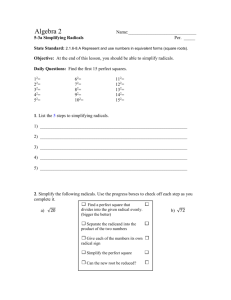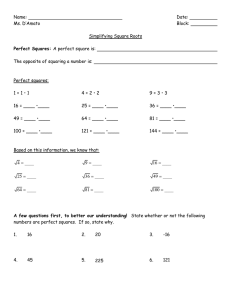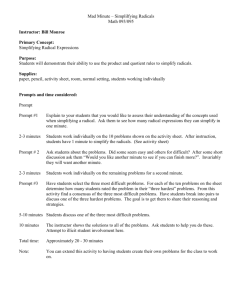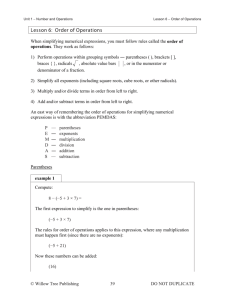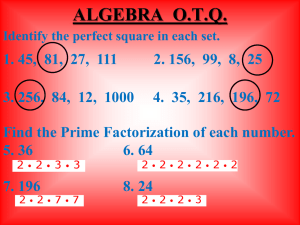simplifying-radical
advertisement
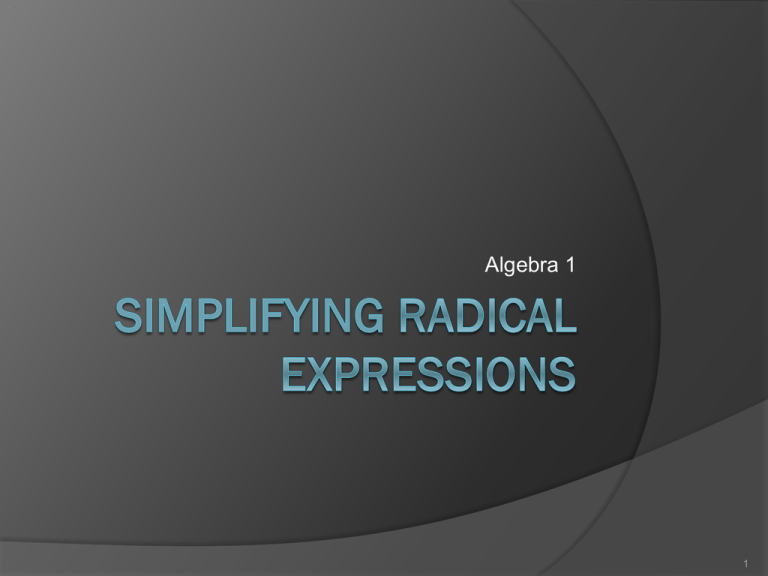
Algebra 1 1 Essential Properties to Understand Product Property of Like Bases Division Property of Like Bases Division Property of Equality Product Property of Radicals Quotient Property of Radicals Power to a Power Property 2 Product Property of Like Bases Multiplication of like bases is equal to the base raised to the sum of the exponents. The base stays the same, even if it is a number. Keep in mind why we must add exponents here… 3 Product Property of Like Bases 6 threes being multiplied together, or Which also comes from 4 Examples Click tab to reveal answer Ex. 1) Ex. 2) Ex. 3) Ex. 4) 5 Non-Example A common student mistake is to multiply the bases when the bases are numbers. Don’t you make this mistake! 6 Division Property of Like Bases Division of like bases is equal to the base raised to the difference of the exponents. Order of the subtraction matters! The base stays the same, even if it is a number. Keep in mind why we must subtract exponents here… 7 Division Property of Like Bases Simplify the fraction Which also comes from 8 Power to a Power Property A power raised to a power is equal to the base raised to the product of the exponents Keep in mind why we must multiply the exponents here… 9 Power to a Power Property 12 twos being multiplied together, or Which also comes from 10 Examples Ex. 5) The 2 does not get the exponent of 4 Ex. 6) Ex. 7) * Keep in mind, each member of the group will have the exponent of 3 applied to it using this property. 11 Transition to Radicals Now that we have the basic exponential properties down, the next 3 slides will introduce properties of radicals. This will be followed by examples and instruction that apply these new properties. 12 Product Property of Radicals The square root of a product is equal to the product of the square roots of each term. This property does not apply to expressions that have addition or subtraction under the radicand. 13 Quotient Property of Radicals The square root of a quotient is equal to the quotient of the square roots of the two terms. This property will apply even when there are operations applied within the individual radicals being divided, as in 14 Division Property of Equality Dividing a square root by itself equals 1. Just as in the Quotient Property of Equality, the operations under the radical can be anything, so long as the numerator and denominator are identical. 15 Simplifying Radicals is Like Simplifying Fractions In fractions, dividing out the largest factor is most efficient. To be efficient in simplifying radicals, we want to use the largest perfect square value. 16 To Simplify a Radical Expression Case 1: Take the square root of the perfect square number(s) and/or variable(s) Case 2: Take the square root of the largest perfect square factors of the expression, while keeping factors have no square numbers as their factors under the radical. 17 Simple Case 1 Examples Click tab to reveal answer Ex. 8) Ex. 9) Ex. 10) Goal: To find the largest square value under the radical. Ex. 11) Ex. 12) 18 Special Case in Simplifying If a variable expression with one or more odd exponents results from a square root, absolute value bars must enclose the expression to ensure no complex numbers result from taking the square root of a negative value. For example: 19 Simplifying Radical Expressions Ex. 13) Factor 32 into a Perfect Square Number and a Non-Perfect Square Number Product Property of Radicals Square root of 16 Simplified Expression Note: Perfect square number is on the left and non-perfect square number is on the right under the radical. 20 Alternative Method to Ex. 13 Similar to the example with numeric fractions, Example 13 can be simplified by using the perfect square number 4 twice. This can be called the “Scenic Route”, but it will provide the same correct simplified radical expression. Notice if we simplify with 4 twice, 4 ∙ 4 = 16; therefore, 16 is the largest perfect square number as a factor of 32. 21 Scenic Route Simplifying using the perfect square number 4 Simplifying using the perfect square number 4 a 2nd time Simplified Expression 22 Simplifying Radical Expressions Ex. 14) For this example, we have options. We could … a) Simplify each radical first, and then multiply. Keep in mind, there may be a need to simplify after multiplying, or b) Multiply first, and then simplify. This method could produce large numbers that may be difficult to simplify. 23 Simplify First…Method a) Simply first using the perfect square value 4 in the second radical. Commutative Property Product Property of Radicals Simply again using the perfect square value 4. Simplified Expression 24 Multiply First…Method b) Product Property of Radicals Simply using the largest perfect square value 16. Simplified Expression Note: By simplifying with the largest perfect square value, the number of steps are reduced substantially. 25 Simplifying Radical Expressions Ex. 15) Notice, there are no common factors between 17 and 144 Quotient Property of Radicals Simplify Perfect Square Root 26 Rationalize the Denominator A radical expression is not simplified when a radical remains in the denominator of a fraction. To simplify, the Division Property of Equality must be used This creates a perfect square value under the radical. When simplified, a value and/or a variable results; therefore, the radical is no longer part of the expression. 27 Simplifying Radical Expressions Ex. 16) Rationalize the Denominator Product Property of Radicals 1 Simplify Integers 3 Simplified Expression 28 Important Points The 2 in the numerator cannot be simplified with the 6 in the denominator, since the 6 is under the radical. The 6 under the radical cannot be simplified with the 6 in the denominator; however, the coefficient 2 and the 6 in the denominator can be simplified, since they are both integers. 29 Simplifying Radical Expressions Ex. 17) Similar to Example 16, we have options… a) We could simplify each radical then divide and/or simplify, or b) We could use the Quotient Property of Radicals, divide first, then simplify further if necessary. 30 Dividing First…Method b) Because 256 is divisible by 32, Method b) is the most efficient method in this example. Quotient Property of Radicals Simplify using the perfect square value 4. Simplified Expression 31 Simplify First…Method a) 4 1 Simplify using the perfect square value 16 in both numerator and denominator. Simplified fraction, but not simplified radical expression 32 Continuation of Method a) Rationalize the Denominator 2 Simplify Integers 1 Simplified Expression This would certainly be the Scenic Route! 33 Simplifying Radical Expressions Ex. 18) Let’s first break each factor down into square parts and non-square parts using the Product Property of Like Bases. is the square value Is a square value is the square value 34 Simplifying Radical Expressions Rewriting the radical expression in a similar fashion to when just numbers are involved, Take the square root of the perfect square values. Don’t forget absolute value bars! 35 Simplifying Radical Expressions Ex. 19) The 4 and 2 cannot be simplified! Rationalize the Denominator Product Property of Radicals 36 Simplifying Radical Expressions Simplify the perfect square value or in the denominator. Don’t forget to include absolute value bars, since the remaining exponent is odd. 2 Simplify Integers 1 Simplified Expression 37 Simplifying Radical Expressions Ex. 20) For this example, we have options. We could … a) Simplify the radical first, and then divide. Keep in mind, there may be a need to simplify after dividing, or b) Divide, or simplify the fraction first, and then simplify the radical. 38 Simplify the Radical First…Method a) Quotient Property of Radicals & Rationalize the Denominator Product Property of Radicals & Multiplication of Like Bases Separating into Perfect and Non-Perfect Squares in the Numerator, and Simplifying the Denominator 39 Continuation of Method a) Product Property of Radicals Square Root of Perfect Square 4 m p2 Simplify Monomial Expressions 3mp Simplified Expression 40 Simplify the Fraction First…Method b) Simplify the Monomial Expressions within the Radical Quotient Property of Radicals Rationalize the Denominator Note: You could simplify the radical in the numerator first before rationalizing. 41 Continuation of Method b) Product Property of Radicals; Separate Numerator into Perfect Square and NonPerfect Square Square Root of Perfect Square & Simplified Expression 42
